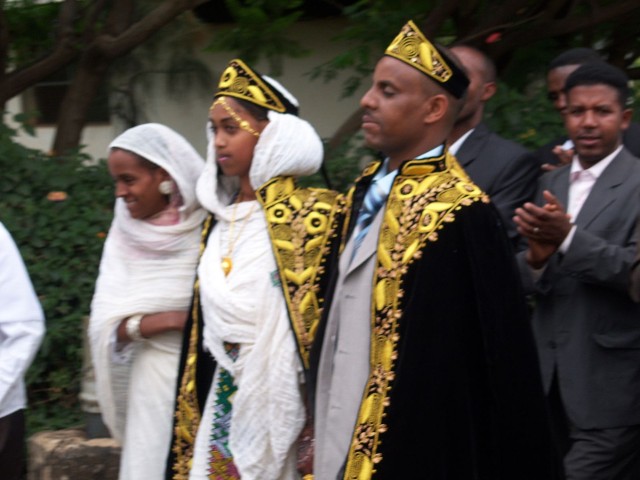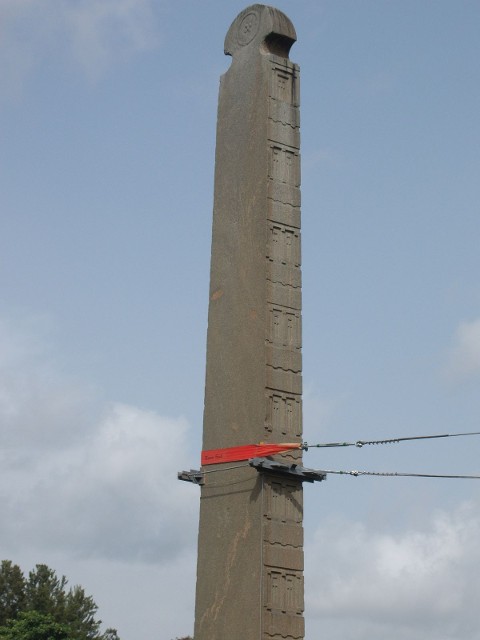| |
|
Teacher Resources

|
 |
An Omoro Wedding.
Pictured at the top of the page is the resting place of the
Arc of the Covenant.
The history of Axum, one of the great Kingdoms of the world, links to Lalibela, from which the Arc of the Covenant may have been housed in one of the underground tunnels then traveled to be guarded in the church above, also supposedly housing an underground catacomb. In Axum it is said that one celibate priest guards the Arc of the Covenant for a lifetime, and then passes the privilege down to another who does the same. Of course, no one is allowed inside, except that one priest, so no one else has ever seen the Arc. Women are not allowed even on the church grounds, but men can get closer; I was stuck using my telephoto.
This is also the home of the Queen of Sheba who birthed King Menelik I (along with Jerusalem's King Solomon, his father). Menelik I is the one attributed with stealing the Arc of the Covenant from Jerusalem when he went to meet his father. You will see the bathing pools of the Queen of Sheba in the photos below.
* You may turn the sound on the audio off to view the videos below.
|
|

Axum's famous 1,700-year-old obelisk is being reinstalled, as it
has finally been cut in half and returned by Italy.
|
In northern Ethiopia a pit has been prepared to accommodate a vast obelisk that was looted from Axum by Mussolini in 1937. The obelisk - the only one on two continents weighing over 100 tonnes - was situated in a square in Rome in front of what was once the ‘Ministry for Italian Africa’ (now the FAO building). Meanwhile Ethiopians await, with barely suppressed excitement, its return to Axum where it will take its place among other obelisks on the original site.
History
The Axumite kingdom was established between 200 and 100 BC and was once one of the four kingdoms of the world. The legendary Queen of Sheba reigned in the region eight or nine centuries earlier; her historic journey to King Solomon’s court in 980 BC, with 700 camels loaded with gold, ivory and other gifts, is well documented in the Old Testament. Her bathing pool and substantial remains of her palace can still be found in Axum.
The kingdom’s influence spread throughout the Horn from eastern Sudan to Berbera. The Axum civilisation was one of the first to adopt Christianity (in the early 4th century), but the obelisks pre-date the Christian period. Perceived as the cradle of Ethiopian civilisation and once the gateway between Africa and Asia, Axum was a thriving trading centre when Jesus was preaching in Palestine. Ships from Egypt, India and other countries in the orient stopped off there to load up with gold, ivory, incense, spices, hides as well as live animals such as elephants and monkeys.
|
Axum Archaelogical Site, Tigray
|
The Site
Axum is home to the world’s tallest obelisks. The stolen obelisk and others are carved with ‘doors’ and ‘windows’ and is thought, like Stonehenge, to have some solar or astronomical measuring role.
|
|
As per http://www.ethiopiantreasures.co.uk/pages/aksum.htm:
Whilst it cannot be proved that the Queen of Sheba had a son with King Solomon, but there is evidence of the Queen of Sheba's visit to King Solomon in Jerusalem, in the Old Testament of the Holy Bible, the First Book of Kings, chapter 10, verses 1 - 10 says:
The queen of Sheba heard of Solomon's fame and came to test him with hard questions. She arrived in Jerusalem with a very large retinue, camels laden with spices, gold in great quantity, and precious stones. When she came to Solomon, she told him everything she had in her mind, and Solomon answered all her questions; not one of them was too abstruse for the king to answer. When the queen of Sheba saw all the wisdom of Solomon, the house which he had built, the food on his table, the courtiers sitting round him, and his attendants standing behind in their livery, his cupbearers, and the whole-offerings which he used to offer in the house of the Lord, there was no more spirit left in her. Then she said to the king, 'The report which I heard in my own country about you and your wisdom was true, but I did not believe it until I came and saw for myself. Indeed I was not told half of it; your wisdom and your prosperity go far beyond the report which I had of them. Happy are your wives, happy these courtiers of yours who wait on every day and hear your wisdom! Blessed be the Lord your God who has delighted in you has set you on the throne of Israel; because he loves Israel for ever, he has made you their king to maintain law and justice.' Then she gave the king a hundred and twenty talents of gold, spices in great abundance, and precious stones. Never again came such a quantity of spices as the queen of Sheba gave to king Solomon.
When Menelik grew up (about 22 years old), he asked his mother who his father was and told him that it was King Solomon of Israel. Menelik told his mother that he wanted to go to visit his father in Jerusalem. He went to Jerusalem to visit his father and Solomon received him with great honour. Menelik stayed with his father in Jerusalem and learnt the Law of Moses for 3 years. Menelik looked very like his father, which confused the Israelites as they had difficulty in telling the difference between Solomon and Menelik. Because of this confusion they complained to King Solomon and asked him to send Menelik home. King Solomon said if they wanted him to send his son back home the high priests would have to send their oldest son and 1000 people from each tribe of Israel with Menelik. The high priests agreed to send their oldest son and 1000 people from each tribe with Menelik.
Menelik then returned to Aksum, amongst those accompanying him was Azariah the son of the high priest (Zadok) of the temple of Jerusalem. Before the journey Azariah had a dream that told him to take the Ark of the Covenant with him to Ethiopia. Azariah did what the dream told him to do and he stole the Ark from the Temple, putting in its place a copy. Azariah told Menelik what he had done and Menelik was angry with him but Azariah convinced Menelik to take the Ark with them. Zadok, the high priest of the Temple, discovered the Ark's disappearance and informed King Solomon. King Solomon and his army followed Menelik but could not catch him. Whilst this was taking place Solomon dreamt that his son should have the Ark and he returned to Jerusalem and ordered his high Priests to keep its disappearance a secret.
On his return to Ethiopia, Menelik founded the "Solomonic Dynasty" and the Aksumite kingdom adopted Judaism and the Law of Moses. The visit of the Queen of Sheba to King Solomon as mentioned in the Holy Bible signifies to the Ethiopians their claim to be direct descendants of the "Solomonic Dynasty". This shows that Judaic culture was established and followed in Ethiopia since the reign of King Menelik. When the Aksumite kingdom accepted the arrival of Christianity, during the reign of King Ezana in the fourth century, the Felashas (Beta Israel or Ethiopian Jews) refused to accept Christianity and continued to practise Judaism, which they still do today.
The Ark of the Covenant is the most reserved holy relic of God's incarnate and became part of the Ethiopian Orthodox Tewahedo Christian belief. The presence of the Ark of the Covenant in every Ethiopian Orthodox Tewahedo Church and the belief in it, exert a profound influence on the imaginations and spiritual lives of many Ethiopians. According to the Ethiopian Orthodox Tewahedo Church, this priceless treasure (the Ark of the Covenant) still exists and rests in a small chapel in the monastic complex of Saint Mary of Zion church in Aksum. This makes Saint Mary of Zion the holiest sanctuary in Ethiopia. It does seems likely that the Ark was brought to Ethiopia when Menelik returned to Aksum from his visit to his father, King Solomon. Ever since the Ethiopian monarch claimed to be a direct descendant from the biblical King Solomon and the Queen of Sheba, and ruled Ethiopia in an unbroken line until the revolution broke out in 1974 which ended the Ethiopian monarchy. For more information about the history and the whereabouts of the Ark of the Covenant, visit www.jewishvirtuallibrary.org/jsource/Judaism/ark.html and www.ethiopianorthodox.org/amharic/holybooks/arkofthecovenent.pdf.
The original church of Saint Mary of Zion was built in the fourth century during the reign of King Ezana who converted the Aksumite kingdom to Christianity. A replica of the Ark of the Covenant, known as the tabot (the tablet), is kept in the holy of holies (Maqdas) in every Ethiopian Orthodox Tewahedo Church to indicate that the church has been duly consecrated as no church is considered consecrated without a replica of the Ark of the Covenant. The Ark of the Covenant is now kept in a small chapel built in 1965 on the orders of Emperor Haile Selassie, which stands at the heart of Aksum's monastic complex of Saint Mary of Zion (Mariam Tsion) church. One holy monk is elected and charged with its care and preservation. The elected monk becomes the official guardian of the Ark and no one, except the elected Guardian (a monk) who looks after the Ark of the Covenant, is allowed to enter the chapel. Before the guardian dies, according to Aksumites tradition, he must nominate his successor.
Aksum remained the capital where the coronations of emperors and empress were held until the reign of Emperor Haile Selassie. It has become Ethiopia's most important centre of Orthodox Tewahedo Christian faith with many archaeological remains of interest and historical significance. These include the palace of Queen of Sheba, tombs of King Ezana and King Gebre Meskel, the magnificent Stelae (obelisks), the bath of Queen of Sheba, the monastic complex of Saint Mary of Zion, the chapel which houses the Ark of the Covenant and the city's antiquities museum. Aksum is now one of the most visited historical city in Ethiopia. |
Videos of the history of Axum:
|
|
|
|